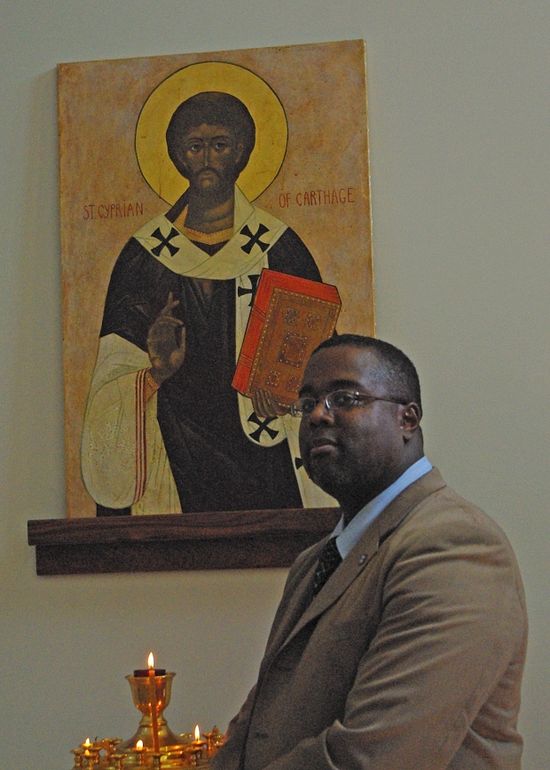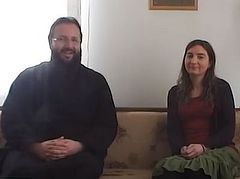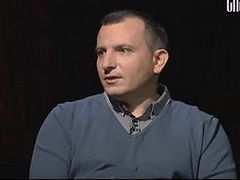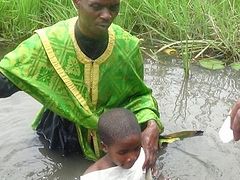Source: The Modern Monastic Order of St. Simon of Cyrene
February 3, 2016
I have a friend who is considering becoming an Orthodox Christian. She is African-American and is concerned that by joining the Orthodox Church that she would be turning her back on black culture. While she likes everything about the ancient faith, she notices the lack of Negro spirituals and the preaching style of the church we grew up in. Also, except for me, I am the only native black American in the parish. While she is used to being the only black in some circles in her upbringing, that she would be a little more comfortable making the same plunge that I did if she saw more of us in the same pool. How is it possible to maintain a strong black identity in this white church?
As I have written in a previous article, the Orthodox Church is the white church that is not. Much of its spirituality comes from the teachings of the Desert Fathers of the Nile Valley. It is not uncommon for Eastern European monks and nuns to trace their ascetic practices back to St. Anthony of Egypt or St. Moses of Ethiopia. St. Athanasius, who was described by his rivals as a black dwarf, is the acknowledged hero of the First Ecumenical Council which underlined the true doctrine of the pre-existence of Jesus Christ. This saint would go on to be Bishop of Alexandria and all Africa and compile the books of the New Testament in 367 AD and the New Testament was officially canonized in a conference in Carthage 30 years later. Almost no White Anglo-Saxon Protestant church in this country would admit to such things. What saddens me is that very few, if any, African-American Protestant churches teach these things on a regular basis.
Also, the whites from Eastern Europe had nothing to do with the chattel slavery of our ancestors nor established the Jim Crow laws. Greeks and Serbs were slaves to the Ottoman Turks up until the early 1800’s. Russian monks defended the humanity and rights of Native Alaskans and helped push for the liberation of serfs (semi-slaves) in their own nation. Arabs, Lebanese, and Syrians do not consider themselves to be white. As for the Egyptians and Ethiopians, they certainly aren’t white. Thus, for a black American to become an Orthodox Christian is to join a universal body of believers that are not defined by Thomas Jefferson’s assumed white supremacy and Finis Dake’s Biblical misinterpretations of black “inferiority.”
Being an Orthodox Christian, I see myself as transcending America’s ignorant defining wall of race and embracing the ancient sense of being both black and Christian. In my icon corner, I have Cyprian of Carthage, Moses the Ethiopian, John the Dwarf and other heralded saints of Africa. As well, I have a dark skinned Theotokos and Christ that was written in the Slavic tradition and the Kursk-Root Icon of the Theotokos which is one of the holiest images of the Russian Orthodox Church. The pale skinned Christ Pantocrator at the top of my corner is the 6th century icon from Africa’s Sinai Peninsula. But, there is an Ethiopian icon of the Nativity beside it. I reject the American tradition of iconoclasm as it lends itself to white supremacy. I fully embrace the Orthodox tradition of iconography as ours is the faith of all peoples from the very beginning. Of course, my Baptist upbringing is against “graven images” on biblical grounds. But, Orthodoxy Christianity also uses the bible to support the use of these “windows into heaven.” And the very first Orthodox Church I attended, St. Cyprian of Carthage in Richmond, I saw full sized icons of black saints and saw “white” people going up to, bowing before, and kissing them. Who’s interpretation should I trust; that of the ones who defended legal segregation and still maintains it by custom? Or, the multi-racial church leaders who came together in the eighth century who defined the proper place and use of holy images in the life of the Christian who knew no reason for skin color prejudice?
Being Orthodox, I am opposing the American Protestantism which ignores the history and wisdom of the African saints. Why should I not pray the words of St. Macarius the Great when Serbian school children have them in their prayer books? Why should I not seek guidance in the wisdom of St. Pachomius when Russian monks in West Virginia embrace the very lifestyle he taught? Oh don’t get me wrong; I honor my mother and father, rely on the strength of Harriet Tubman and David Walker, enjoy traditional black spiritual music, and have nothing against the Black Lives Matter fight against police brutality. But, any faith that teaches me that the African Saints don’t matter is a faith that does not teach black people the fullness of who they are in the eyes of God. The Orthodox maintain this Christian fullness with that of other holy men and women from Europe and the Near East. Fathers Seraphim Rose and Alexander Schmemann (two pillars of the Orthodox Church in the United States) frequently referred back to desert fathers in the formation of Christian worship and spiritual discipline as well as the monks of Mt. Athos or Valaam Monastery. Even in those hallowed places of contemplation, the African saints are highly revered. I see no reason why I shouldn’t follow suit.
Do I miss the form and style of African-American preaching? Sometimes I do. But, style without substance and sincerity is wasted. You take Dr. CAW Clarke, one of the greatest black preachers from back in the day. That man could “whoop” a sermon from the invocation to the benediction. But, his style was born out of the intense suffering of our people during the Jim Crow era that he lived in. Clark didn’t just “whoop,” but gave a lot of spiritual truth to his listeners. Too many preachers try to imitate his style not because of shared suffering, but out of the idea giving people what they like to hear. The same is true with the delivery style of Gardner C. Taylor (my biggest preaching influence). His slow and deliberate rise to a rousing crescendo of a shout was a reflection of the pain we suffer in this world rising to the hope and victory in the life of Christ. He did this with a theological mind second to none. While racism is still alive and well in this country, most black Christians have little or no idea what it is to have suffered like our parents and grandparents. We have lost the sense of humble suffering and reliance on God that they had as we are often too quick to protest the very slightest insult against us. Thank God the days of Jim Crow are (well, mostly) gone. But, without the sense of humble suffering and reliance on God for deliverance from this world and personal sin, our best Clarke and Gardner styles are mere mockeries.
Sadder still is the fact that so many black preachers today aren’t even trying to emulate these classic ministers. Way too often, modern preaching is dictated by whatever seems popular on “Christian” television. The mannerisms and styles of whatever preacher is amassing a great number of followers and generating the largest income is the patter that is being pedaled as “anointed preaching.” There is a great reliance on “Christianized” secular slogans to excite people to a point that some of the same things heard in a Friday or Saturday night dance club can be heard in a Sunday Morning sermon. “Turn around three times and give a ‘high five’ to your neighbor.” “Ain’t no party like a Holy Ghost party ’cause a Holy Ghost party don’t stop.” If the old mothers of the Baptist church I grew up in could rise from the grave and hear this sort of preaching, a lot of ministers would be getting whippings!
The same is true for black religious music. Our slave ancestors didn’t have the luxury of pianos. They clapped, stomped, and perhaps played a drum. The songs they made came out of a faith born in struggle with both the outer demons that oppressed them and the inner demons of sin. During segregation, that same sense of music made in a faith born out of struggle carried over on pianos and in some cases, other instruments (at least one branch of black Pentecostalism had horns). Contemporary Gospel, like that in white American Christian circles, is nothing more than a Christian label thrown on the secular music forms. What is heard on a Rhythm & Blues radio station is no different than the Gospel station. Some of the “liturgical dance” performed even in the morning worship in some churches is the same as seen in dance clubs. Instead of the church being a thermostat of Godly change in the souls of black Christians, it is too often a thermometer going along with whatever is going on for the sake of being “relevant” and keeping young folk in the church. Sadly enough, one of the reasons why youth and young adults leave and aren’t very active in the church (black or white) is that secular music and dance is a lot more professionally done and done with more talent than the entertainment that is in church.
I recognize the best of my African-American Christian heritage. Among my treasured icons of the saints are photos of people who contributed greatly to my spiritual development. My cousin Oppielee, Deacon Louise Kersey, was known for her godly wisdom and love for others. Alex and Zechariah Jones were uncles I never knew but were known as no-nonsense deacons at St. John’s Baptist Church. Deacon H. L. Mays was my shop teacher and a well-loved example of Christian manhood. My mentor in ministry and grandfather in law, Rev. Carter Wicks, took my narrow behind under his wing when it came to being a preacher and pastor. I am ever mindful of the road they paved for and the legacy they left me as I pray before them and the other icons every morning and evening. I kept the name I was given at birth when I was Chrismated into the Church out of respect for the two men whose legacy I will carry unto death. My Uncle John R. Thompson was a United States Marine when blacks weren’t supposed to be good enough to be Marines. After serving our nation in WWII, Johnny was known as a giving man who extended a hand of friendship to anyone who needed one. My father, John Robert, Sr., quietly broke color barriers as his aptitude test scores for AT&T technical trainees were among the highest in his entry class. Today, he is one of the most respected deacons in King William County for his wisdom and community service. I wasn’t asked to change my upbringing to become an Orthodox Christian. I didn’t.
But, my father also taught me not to follow what everyone else was doing for the sake of being like everyone else. So, I stand on his shoulders and those of Uncle Johnny. I am rooted in the faith of Dr. Clarke and Deacon Oppeliee. But, I have taken my African-American identity to the table where Moses the Black speaks with John Chrysostom. I stand with Ephrem the Syrian and Cyprian of Carthage. I take from the chalice of Ireland’s Patrick and Egypt’s Mary. Just as Malcolm X urged black Americans to look beyond the struggle of national Civil Rights and bring our struggles into the realm of worldwide human rights, I have brought my faith to the older and broader Church. I pray my friend will see this and, in God’s time and way, come home to Orthodoxy. I pray others will do likewise.




